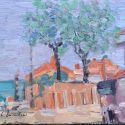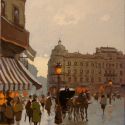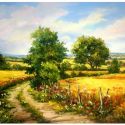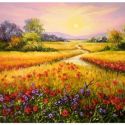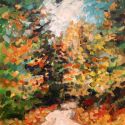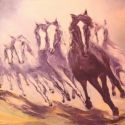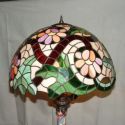Born on 08 April 1861: Irving Ramsey Wiles, US painter, mostly of portraits, who died in 1948.
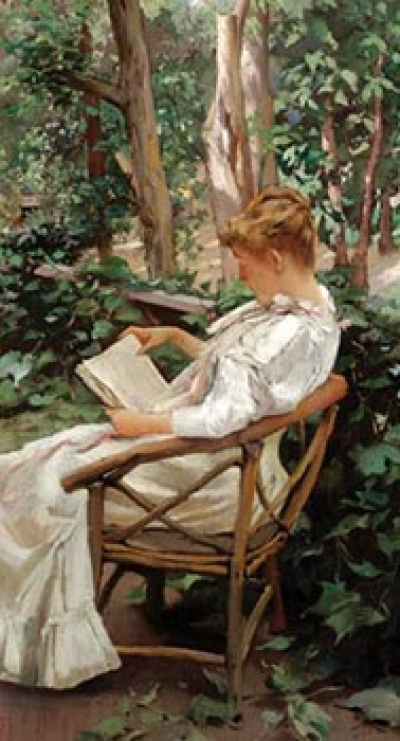
Born in Utica, New York, Irving Wiles was educated at the Sedgwick Institute, Great Barrington, Massachusetts. He learned the basics of art from his father, Lemuel Maynard Wiles [1826-1905], who maintained a studio on Washington Square in New York City, and then studied in New York City for a year in 1879 at the Art Students League under Thomas Wilmer Dewing [1851-1938], J. Carroll Beckwith [1852-1917], and William Merritt Chase [1849-1916]. The fledgling school, incorporated the year before, had recently added several new instructors to its staff, including Chase who had just returned from Munich. Wiles continued his studies in Chase's opulent Tenth Street Studio, where he was exposed to European paintings, including Chase's own copies of the old masters.
Encouraged by Chase and other League instructors, Wiles decided to complete his studies abroad in 1882. In Paris, he continued his training in drawing at the Ecole des Beaux-Arts, at the same time pursuing a more direct approach to painting under the guidance of Sargent's teacher, Carolus-Duran. He went to Paris for a year as a student of Carolus-Duran [1838-1917] and Jules Lefebvre [1836-1911]. He also studied under Leon Bonnat and Ernest Hebert.
When Wiles returned to New York in 1883 he supported himself as an illustrator, and in 1884, he also assumed a post at the Art Students League. In 1887, he opened his studio at 103 West Fifty-fifth Street, where he gave painting lessons. He also assisted at his father's art school in Upstate New York at Silver Lake, where regular classes were held each summer through 1894. During the 1890s, with a "free, dashing style," he established himself as a portrait, landscape, and genre painter in New York. He won numerous prestigious prizes in New York and at the Paris Salon. He was one of eight painters commissioned by the National Art Committee to paint the history of World War I. He also did a portrait of William Jennings Bryan. In about 1895, he and his father began conducting summer art classes on the North Fork of Long Island, and subsequently Irving purchased land and built a studio at Peconic and was there until his death.
In 1879 Irving Ramsey Wiles followed his father's advice and moved to New York. He entered the Art Students League, where he spent two years studying under Thomas W. Dewing, J. Carroll Beckwith and William Merritt Chase, who was to become his friend and mentor. He went to Paris in 1882, and spent his first months there at the Academie Julian under the direction of Gustave Boulanger and Jules Joseph Lefebre, before being admitted to the private atelier of Emile Auguste Carolus-Duran.
After returning to the US in 1884 Wiles resumed study at the League, and began to exhibit at the National Academy of Design, the American Water Color Society, and, from 1886 until 1906, the Society of American Artists. Wiles supplemented his income by producing illustrations for Harper's Magazine, The Century Magazine, and Scribner's Monthly. From 1884 to 1894 he spent summers operating the Silver Lake Art School at Ingham, New York, with his father. Shortly after his return to the US he won a number of prestigious awards, including a bronze medal at the 1893 Chicago World's Columbian Exposition.
Wiles was elected an associate member of the National Academy of Design in 1889, and became a full member in 1897. Beginning in the early 1890s, Wiles achieved recognition for his fashionable interior genre scenes and society portraits of women and children. His professional reputation was assured after 1902, when his portrait of the actress Julia Marlowe was exhibited at the National Academy. From then until the late 1920s, when old age and ill health forced him to retire, Wiles received portrait commissions from the US's most wealthy and socially prominent citizens. Highly competent in the field of male portraiture, he was one of eight US artists selected in 1919 by the National Art Committee to paint portraits for a pictorial history of World War I.
Toward the end of his career Wiles was noted for the plein-air land and seascapes he painted at his home in Peconic, Long Island, where he died in 1948. Along with John White Alexander and Cecilia Beaux, Wiles was one of the most popular US portraitists active during the first quarter of the twentieth century. He was an exponent of grand manner portraiture as it had been redefined during the late nineteenth century by John Singer Sargent, Giovanni Boldini and James Whistler. Wiles produced convincing likenesses without detracting from them by placing undue emphasis on technical virtuosity. Like Sargent, he was influenced by the expressive painterly technique of Hals and Velasquez, and his style bears the strong imprint of Chase. Although he freely incorporated impressionist color and brushwork into his technique, Wiles remained a conservative artist who never became associated with any of the avantgarde movements that developed during his lifetime.
inchide 
Newsletter
Stay tuned with arts. Subscribe to Artline art news send directly to your mailbox by artLine.ro



